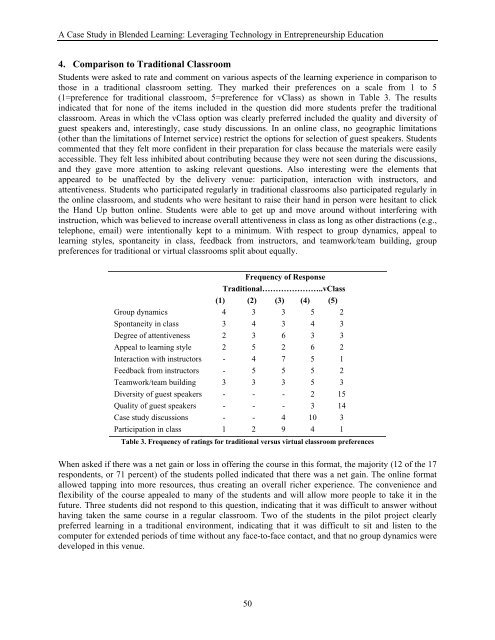Elements of Quality Online Education cation
Elements of Quality Online Education cation
Elements of Quality Online Education cation
Create successful ePaper yourself
Turn your PDF publications into a flip-book with our unique Google optimized e-Paper software.
A Case Study in Blended Learning: Leveraging Technology in Entrepreneurship <strong>Edu<strong>cation</strong></strong>4. Comparison to Traditional ClassroomStudents were asked to rate and comment on various aspects <strong>of</strong> the learning experience in comparison tothose in a traditional classroom setting. They marked their preferences on a scale from 1 to 5(1=preference for traditional classroom, 5=preference for vClass) as shown in Table 3. The resultsindicated that for none <strong>of</strong> the items included in the question did more students prefer the traditionalclassroom. Areas in which the vClass option was clearly preferred included the quality and diversity <strong>of</strong>guest speakers and, interestingly, case study discussions. In an online class, no geographic limitations(other than the limitations <strong>of</strong> Internet service) restrict the options for selection <strong>of</strong> guest speakers. Studentscommented that they felt more confident in their preparation for class because the materials were easilyaccessible. They felt less inhibited about contributing because they were not seen during the discussions,and they gave more attention to asking relevant questions. Also interesting were the elements thatappeared to be unaffected by the delivery venue: participation, interaction with instructors, andattentiveness. Students who participated regularly in traditional classrooms also participated regularly inthe online classroom, and students who were hesitant to raise their hand in person were hesitant to clickthe Hand Up button online. Students were able to get up and move around without interfering withinstruction, which was believed to increase overall attentiveness in class as long as other distractions (e.g.,telephone, email) were intentionally kept to a minimum. With respect to group dynamics, appeal tolearning styles, spontaneity in class, feedback from instructors, and teamwork/team building, grouppreferences for traditional or virtual classrooms split about equally.Frequency <strong>of</strong> ResponseTraditional…………………..vClass(1) (2) (3) (4) (5)Group dynamics 4 3 3 5 2Spontaneity in class 3 4 3 4 3Degree <strong>of</strong> attentiveness 2 3 6 3 3Appeal to learning style 2 5 2 6 2Interaction with instructors - 4 7 5 1Feedback from instructors - 5 5 5 2Teamwork/team building 3 3 3 5 3Diversity <strong>of</strong> guest speakers - - - 2 15<strong>Quality</strong> <strong>of</strong> guest speakers - - - 3 14Case study discussions - - 4 10 3Participation in class 1 2 9 4 1Table 3. Frequency <strong>of</strong> ratings for traditional versus virtual classroom preferencesWhen asked if there was a net gain or loss in <strong>of</strong>fering the course in this format, the majority (12 <strong>of</strong> the 17respondents, or 71 percent) <strong>of</strong> the students polled indicated that there was a net gain. The online formatallowed tapping into more resources, thus creating an overall richer experience. The convenience andflexibility <strong>of</strong> the course appealed to many <strong>of</strong> the students and will allow more people to take it in thefuture. Three students did not respond to this question, indicating that it was difficult to answer withouthaving taken the same course in a regular classroom. Two <strong>of</strong> the students in the pilot project clearlypreferred learning in a traditional environment, indicating that it was difficult to sit and listen to thecomputer for extended periods <strong>of</strong> time without any face-to-face contact, and that no group dynamics weredeveloped in this venue.50
















